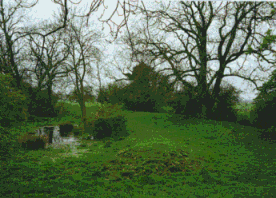LEICESTERSHIRE & RUTLAND
BURTON LAZARS
. This hamlet, close to Melton Mowbray, derives the second half of its name from an ancient leper hospital founded in the twelfth century and which was the principal English house of the crusading
Order of Knights of St Lazarus. The hospital, said to have been one of the largest in Britain, was demolished about a century after the Dissolution but its site on the north west side of the present village is of interest. Very little of the stonework remains above ground but a series of mounds and depressions in a field to the left of the gated road between the village and Sandy Lane gives an idea of the layout.
This hamlet, close to Melton Mowbray, derives the second half of its name from an ancient leper hospital founded in the twelfth century and which was the principal English house of the crusading
Order of Knights of St Lazarus. The hospital, said to have been one of the largest in Britain, was demolished about a century after the Dissolution but its site on the north west side of the present village is of interest. Very little of the stonework remains above ground but a series of mounds and depressions in a field to the left of the gated road between the village and Sandy Lane gives an idea of the layout.
Water from a nearby sulphurous spring may have been used for bathing by the residents afflicted with leprosy though it is doubtful whether any "medical" treatment would have been attempted. It has been suggested that the hospital was more an administrative centre for the Order than a leper colony. In 1913, the site was excavated in a rather amateur manner by the Marquis of Granby. A large area of mediaeval floor tiles was unearthed which are now in the British Museum.
In 1760 the residents of Burton decided to inaugurate their village as a spa and water from the sulphurous spring was piped to a small bath-house built by the side of the Oakham to Melton road. By all accounts the venture proved a dismal failure and the bath-house was pulled down.
LEICESTER.Birth place of Merrick, the Elephant Man.
The Leicester University Library houses the library of the Leicester Medical Society which contain about 2000 volumes. There is also a medical museum in the Leicester Royal Infirmary's Knighton Street Nurses Home which is open to the public from 12noon - 14:00 on Wednesdays only, although visits are possible at other times by prior arrangement. The museum was set up by a former anaesthetist, Dr Aubrey Stewart.
The Infirmary, one of the earlier provincial hospitals, was opened in September 1771. Its founder, the Rev. William Watts, through fund-raising and appeals raised £2,200 to build the then 40-bed hospital. The new Infirmary, like the rest of Leicester had no running water and relied on a well for water supplies. Sanitation was the primitive cesspit. The Infirmary's apothecary was responsible for the herb garden and the Infirmary's own brewery, which supplied beer, used instead of well water for drinking.
MELTON MOWBRAY
.A curious carved stone head, kept in the vestry of St Mary's Church, is said to have once been part of the leper hospital at Burton Lazars. This is an example of a mediaeval sculpted head showing the physical signs of leprosy; everted lower eyelids, collapsed bridge of the nose and withdrawn upper lip indicating destruction of the maxillary bone. A similar stone head can be seen in the
Ashmolean Museum at Oxford.